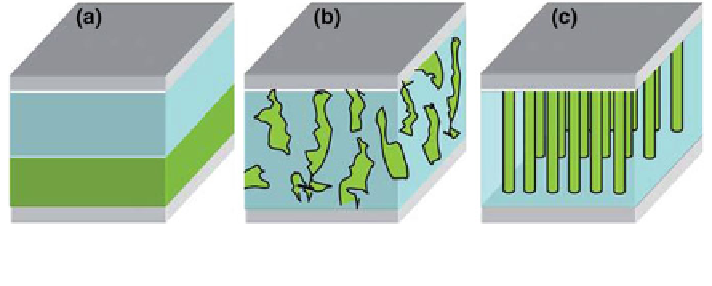Environmental Engineering Reference
In-Depth Information
Fig. 9.3 Three types of device configuration of hybrid solar cells: a bilayer heterojunction,
b bulk heterojunction, c ordered heterojunction. Reproduced with permission from Ref. [
38
]
The bilayer heterojunction HSCs can be easily fabricated by consecutive
depositing the acceptor and donor layers on the substrate; however, the efficiencies
of bilayer heterojunction HSCs are typically much lower than that of BHJ HSCs
[
40
,
41
], due to the reduced D/A interface area and the dilemma of efficient light
harvesting and exciton diffusion [
42
].
Similar problems have also been encountered by the organic bilayer hetero-
junction solar cells and well solved by the design of bulk heterojunction, which is a
three dimensional interpenetrating network of the donor and acceptor materials.
Learning from that, the concept of BHJ could also be applied into HSCs for
improving their performance. The BHJ HSCs can be fabricated through: (1) infil-
trating of polymers into inorganic network, (2) simultaneous deposition of the
blend of polymer and inorganic nanocrystals, and (3) in situ growth of one material
into another.
If the BHJ is formed in ordered inorganic nanostructures, e.g., ordered nanorod,
nanowire, and nanotube arrays, it is also called ordered heterojunction. It is
believed to be the ideal morphology for HSCs, for the direct charge passway and
tunable D/A domain size, both of which are crucial for efficient charge dissociation
and transport [
37
].
9.3 Progress in Hybrid Solar Cells
HSCs have been extensively studied for many years. Although the conjugated
polymers could play a crucial role in determining the efficiencies of HSCs, much of
the research interests have been paid to the development of the inorganic nano-
crystals. Although some new polymers with robust light harvesting properties and
photovoltaic performances have been developed for organic solar cells [
43
-
46
], few
have yet been used into HSCs [
47
]. By now, most of the HSCs are based on poly-
thiophene and poly(p-phenylene vinylene) and their derivatives are shown in
Fig.
9.4
. Herein, we will not discuss much about the conjugated polymers but focus
on the proceedings in inorganic nanocrystals from the point of view of their

Search WWH ::

Custom Search